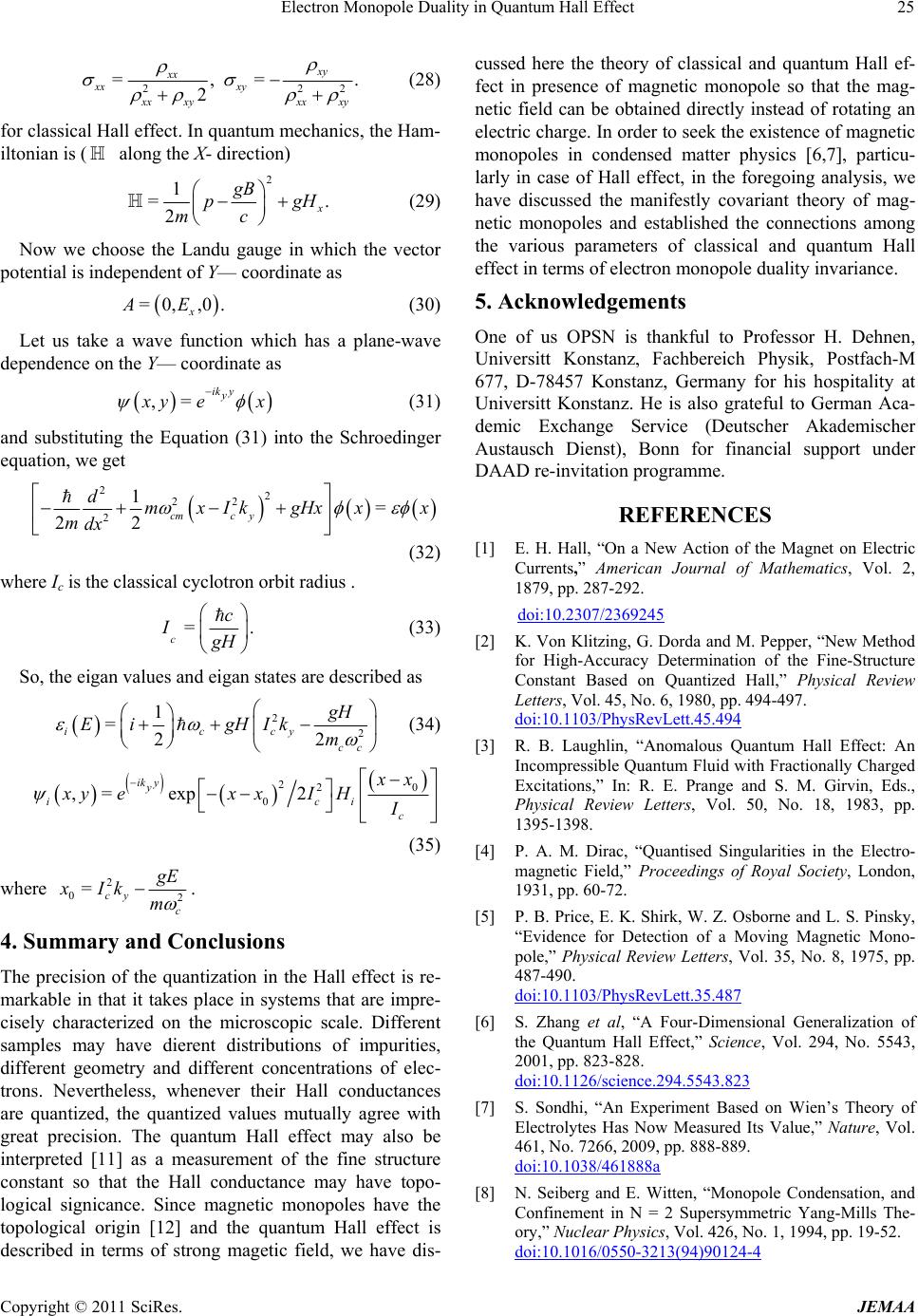
Electron Monopole Duality in Quantum Hall Effect25
2
=, =
22
2
xy
xx
xxxy .
xxy xxxy
(28)
for classical Hall effect. In quantum mechanics, the Ham-
iltonian is ( along the X- direction)
2
1
=
2.
gB
pg
mc
H
(29)
Now we choose the Landu gauge in which the vector
potential is indep e ndent of Y— coordinate as
=0, ,0.
x
AE (30)
Let us take a wave function which has a plane-wave
dependence on the Y— coordinate as
,=
ik y
y
ye x
(31)
and substituting the Equation (31) into the Schroedinger
equation, we get
22
22
2
1=
22
cmc y
dmxIkgHxxx
mdx
(32)
where Ic is the classical cyclotron orbit radius .
=
c
c
I.
H
(33)
So, the eigan values and eigan states are described as
2
2
1
=22
iccy
cc
gH
Ei gHIkm
(34)
20
2
0
,= exp2
ik y
y
ic
ci
x
xyex xIHI
(35)
where 2
02
=cy
c
E
xIkm
.
4. Summary and Conclusions
The precision of the quantization in the Hall effect is re-
markable in that it takes place in systems that are impre-
cisely characterized on the microscopic scale. Different
samples may have dierent distributions of impurities,
different geometry and different concentrations of elec-
trons. Nevertheless, whenever their Hall conductances
are quantized, the quantized values mutually agree with
great precision. The quantum Hall effect may also be
interpreted [11] as a measurement of the fine structure
constant so that the Hall conductance may have topo-
logical signicance. Since magnetic monopoles have the
topological origin [12] and the quantum Hall effect is
described in terms of strong magetic field, we have dis-
cussed here the theory of classical and quantum Hall ef-
fect in presence of magnetic monopole so that the mag-
netic field can be obtained directly instead of rotating an
electric charge. In order to seek the existence of magnetic
monopoles in condensed matter physics [6,7], particu-
larly in case of Hall effect, in the foregoing analysis, we
have discussed the manifestly covariant theory of mag-
netic monopoles and established the connections among
the various parameters of classical and quantum Hall
effect in terms of electron monopole duality invariance.
5. Acknowledgements
One of us OPSN is thankful to Professor H. Dehnen,
Universitt Konstanz, Fachbereich Physik, Postfach-M
677, D-78457 Konstanz, Germany for his hospitality at
Universitt Konstanz. He is also grateful to German Aca-
demic Exchange Service (Deutscher Akademischer
Austausch Dienst), Bonn for financial support under
DAAD re-invitation programme.
REFERENCES
[1] E. H. Hall, “On a New Action of the Magnet on Electric
Currents,” American Journal of Mathematics, Vol. 2,
1879, pp. 287-292.
doi:10.2307/2369245
[2] K. Von Klitzing, G. Dorda and M. Pepper, “New Method
for High-Accuracy Determination of the Fine-Structure
Constant Based on Quantized Hall,” Physical Review
Letters, Vol. 45, No. 6, 1980, pp. 494-497.
doi:10.1103/PhysRevLett.45.494
[3] R. B. Laughlin, “Anomalous Quantum Hall Effect: An
Incompressible Quantum Fluid with Fractionally Charged
Excitations,” In: R. E. Prange and S. M. Girvin, Eds.,
Physical Review Letters, Vol. 50, No. 18, 1983, pp.
1395-1398.
[4] P. A. M. Dirac, “Quantised Singularities in the Electro-
magnetic Field,” Proceedings of Royal Society, London,
1931, pp. 60-72.
[5] P. B. Price, E. K. Shirk, W. Z. Osborne and L. S. Pinsky,
“Evidence for Detection of a Moving Magnetic Mono-
pole,” Physical Review Letters, Vol. 35, No. 8, 1975, pp.
487-490.
doi:10.1103/PhysRevLett.35.487
[6] S. Zhang et al, “A Four-Dimensional Generalization of
the Quantum Hall Effect,” Science, Vol. 294, No. 5543,
2001, pp. 823-828.
doi:10.1126/science.294.5543.823
[7] S. Sondhi, “An Experiment Based on Wien’s Theory of
Electrolytes Has Now Measured Its Value,” Nature, Vol.
461, No. 7266, 2009, pp. 888-889.
doi:10.1038/461888a
[8] N. Seiberg and E. Witten, “Monopole Condensation, and
Confinement in N = 2 Supersymmetric Yang-Mills The-
ory,” Nuclear Physics, Vol. 426, No. 1, 1994, pp. 19-52.
doi:10.1016/0550-3213(94)90124-4
Copyright © 2011 SciRes. JEMAA